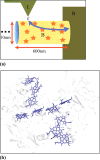Charge transfer in dynamical biosystems, or the treachery of (static) images
- PMID: 25307316
- PMCID: PMC4333612
- DOI: 10.1021/ar500271d
Charge transfer in dynamical biosystems, or the treachery of (static) images
Abstract
CONSPECTUS: The image is not the thing. Just as a pipe rendered in an oil painting cannot be smoked, quantum mechanical coupling pathways rendered on LCDs do not convey electrons. The aim of this Account is to examine some of our recent discoveries regarding biological electron transfer (ET) and transport mechanisms that emerge when one moves beyond treacherous static views to dynamical frameworks. Studies over the last two decades introduced both atomistic detail and macromolecule dynamics to the description of biological ET. The first model to move beyond the structureless square-barrier tunneling description is the Pathway model, which predicts how protein secondary motifs and folding-induced through-bond and through-space tunneling gaps influence kinetics. Explicit electronic structure theory is applied routinely now to elucidate ET mechanisms, to capture pathway interferences, and to treat redox cofactor electronic structure effects. Importantly, structural sampling of proteins provides an understanding of how dynamics may change the mechanisms of biological ET, as ET rates are exponentially sensitive to structure. Does protein motion average out tunneling pathways? Do conformational fluctuations gate biological ET? Are transient multistate resonances produced by energy gap fluctuations? These questions are becoming accessible as the static view of biological ET recedes and dynamical viewpoints take center stage. This Account introduces ET reactions at the core of bioenergetics, summarizes our team's progress toward arriving at an atomistic-level description, examines how thermal fluctuations influence ET, presents metrics that characterize dynamical effects on ET, and discusses applications in very long (micrometer scale) bacterial nanowires. The persistence of structural effects on the ET rates in the face of thermal fluctuations is considered. Finally, the flickering resonance (FR) view of charge transfer is presented to examine how fluctuations control low-barrier transport among multiple groups in van der Waals contact. FR produces exponential distance dependence in the absence of tunneling; the exponential character emerges from the probability of matching multiple vibronically broadened electronic energies within a tolerance defined by the rms coupling among interacting groups. FR thus produces band like coherent transport on the nanometer length scale, enabled by conformational fluctuations. Taken as a whole, the emerging context for ET in dynamical biomolecules provides a robust framework to design and interpret the inner workings of bioenergetics from the molecular to the cellular scale and beyond, with applications in biomedicine, biocatalysis, and energy science.
Figures






References
-
- El-Naggar M. Y.; Finkel S. E. Live Wires. Scientist 2013, 27, 38–43.
-
- Protein Electron Transfer; Bendall D. S., Ed.; Bios Scientific Publishers: Oxford, U.K., 1996.
-
- Nicholls D. G.; Ferguson S. J.: Bioenergetics, 4th ed.; Academic Press: Waltham, MA, 2013.
Publication types
MeSH terms
Substances
Grants and funding
LinkOut - more resources
Full Text Sources
Other Literature Sources
Miscellaneous

